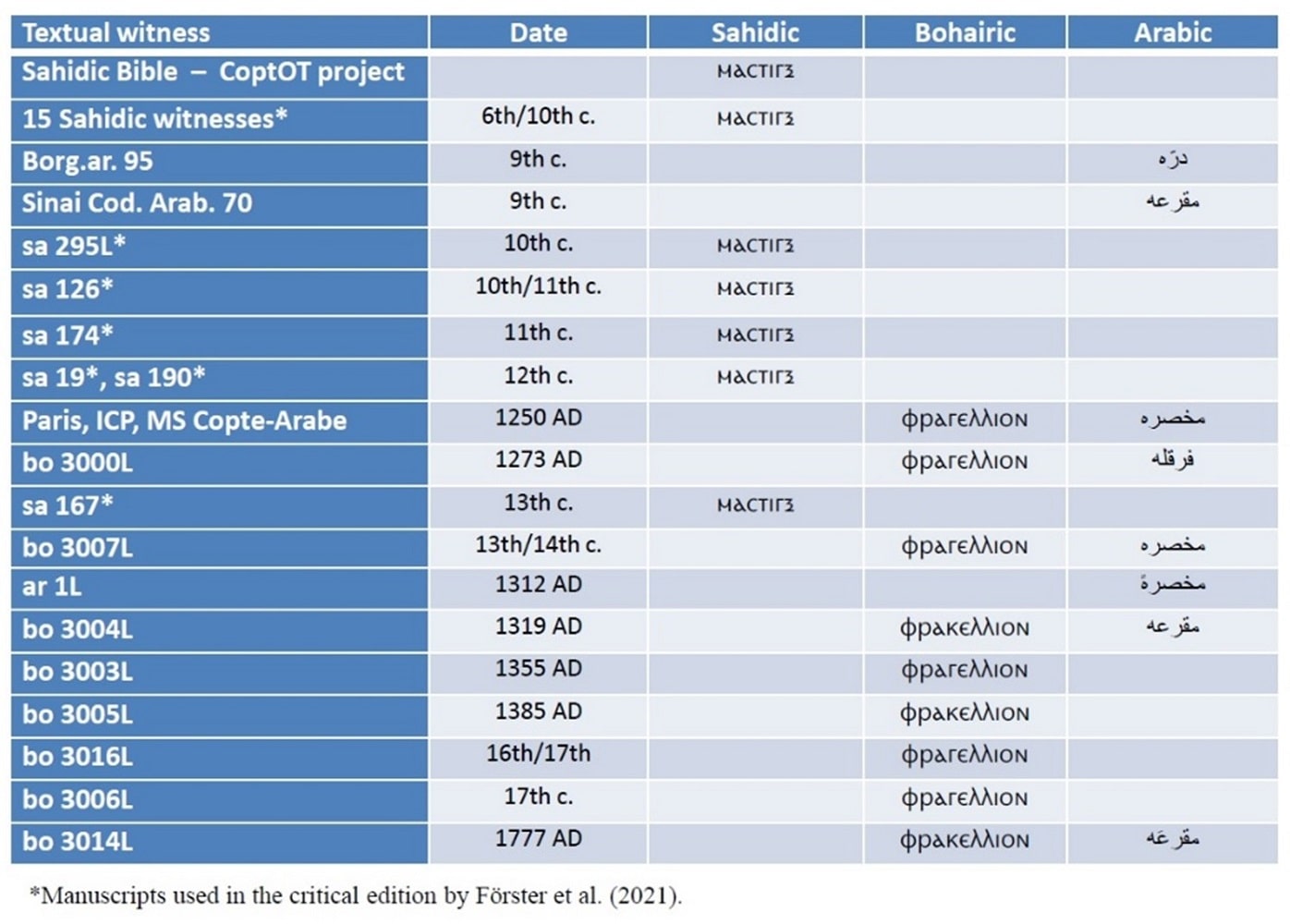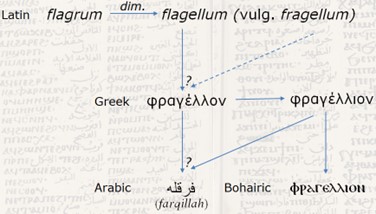In this blog post, I discuss some Coptic and Arabic words for whip or scourge used in the translations of John 2:15 in the Holy Week lectionaries that are part of our project “Digital Edition and Critical Evaluation of the Coptic Holy Week Lectionary”. Let me start with the manuscript that originally piqued my interest in this matter.
Manuscript bo 3000L (according to our classification) is preserved in the British Library under shelf mark Add. 5997 and is the oldest dated Bohairic Holy Week lectionary (henceforth HWL) manuscript (1273 AD). It is bilingual (Bohairic–Arabic) and originates from Nitria in Lower Egypt.[1]
When I was transcribing the bilingual version of John 2:15, which is read during the sixth Hour of the Day on Holy Monday,[2] I came upon the Arabic word فرقله (frqlh), which I was not familiar with, and which seemed to me as an imperfect transliteration of the word ⲫⲣⲁⲅⲉⲗⲗⲓⲟⲛ used in the Bohairic text. The word in Greek means ‘whip’ or ‘scourge’[3] and refers to a kind of whip made of ropes that Jesus used to drive away cattle dealers, money changers, and animals from the temple, a description that is unique to the Johannine account.[4] A quick look at John 2:15 in the Nestle-Aland 28th edition shows that by using ⲫⲣⲁⲅⲉⲗⲗⲓⲟⲛ, the Coptic translator literally follows the Greek version. Also note that the Latin translation uses the similarly sounding word flagellum:
καὶ ποιήσας φραγέλλιον ἐκ σχοινίων πάντας ἐξέβαλεν ἐκ τοῦ ἱεροῦ, τά τε πρόβατα καὶ τοὺς βόας, καὶ τῶν κολλυβιστῶν ἐξέχεεν τὸ κέρμα καὶ τὰς τραπέζας ἀνέτρεψεν.
et cum fecisset quasi flagellum de funiculis, omnes eiecit de templo, oves quoque, et boves, et nummulariorum effudit aes, et mensas subvertit.
Next, I went through other Arabic, Bohairic, and Sahidic versions of John 2:15 and here is a summary of what I found:

Table 1[5] Table of languages and witnesses
As one can see, while Bohairic always uses the word ⲫⲣⲁⲅⲉⲗⲗⲓⲟⲛ in two orthographic variants, Sahidic translates the Greek word φραγέλλιον by ⲙⲁⲥⲧⲓⲅⲝ, as already briefly discussed by Christian Askeland,[6] and, in Arabic, the manuscripts I have considered feature four different translations.[7] In fact, only one of those manuscripts has the Greek word rendered as فرقله, and that is the specific bilingual Bohairic-Arabic HWL bo 3000L described above. As we will see later, the Arabic word, which appears without vowel signs in the manuscript, is read فَرْقِلَّه farqillah.
But how are the similar Latin flagellum, Greek φραγέλλιον, Bohairic ⲫⲣⲁⲅⲉⲗⲗⲓⲟⲛ, and Arabic فَرْقِلَّه farqillah connected? And who borrowed from whom?[8]
The Latin word flagellum is the diminutive of the word flagrum. Although φραγέλλον is usually considered to be a Greek adaptation of Latin flagellum via the dissimilation of the l…l into r…l, I actually think that it can have been borrowed directly from the Vulgar Latin variant fragellum that was already dissimilated.[9] According to all consulted dictionaries, the Greek word φραγέλλον or φραγέλλιον is the source of both the Arabic فَرْقِلَّه farqillah[10] and the word appearing in the Bohairic translations, as you can see in this tentative sketch:

Figure 1 Sketch of loanwords originating from Latin flagellum
We have already seen that all Bohairic text witnesses consistently use the Greek word as is, and what is more, we encounter ⲫⲣⲁⲅⲉⲗⲗⲓⲟⲛ already in an early Bohairic manuscript, namely in papyrus Bodmer III dated to the 4th c. AD.[11]
Let us now look in more detail at each of the words in Table 1, beginning with the words related to Greek φραγέλλιον.
Bohairic ⲫⲣⲁⲅⲉⲗⲗⲓⲟⲛ/ ⲫⲣⲁⲕⲉⲗⲗⲓⲟⲛ
The word is missing from the traditional Coptic dictionaries[12] even as a loanword. It is however mentioned in Cherix’s Lexique grec-copte,[13] and in his Lexique copte (dialecte sahidique!) as a Greek loanword with the French meaning ‘fouet’, which is ‘whip’. The original Greek word is documented, e.g. in Trapp’s Lexikon[14] and in LSJ online,[15] where it is interpreted as a loanword from Latin. In the whole Bible, the Greek word only appears in John 2:15, and hence this is also the only occurrence of the loanword in the Bohairic Bible. The variant with ⲕ might be an adaptation of the Greek loanword to the early Late Bohairic pronunciation in which ⲕ could also stand for /g/.[16] I will return to some more details of ⲫⲣⲁⲅⲉⲗⲗⲓⲟⲛ in the section on ⲙⲁⲥⲧⲓⲅⲝ below.
Arabic فَرْقِلَّه farqillah
Documented in several dictionaries, the word is always classified as an Arabic word used in Egypt, from Greek φραγέλλιον according to Dozy.[17] Another non-liturgical textual witness is no less than an Arabic manuscript of the “Thousand and One Nights” of the 14th c. preserved in Paris at the BnF under shelf mark Arabe 3609 and commented upon by the orientalist Fleischer,[18] who refers to the occurrence of farqillah, on f. 7r. This would be the second textual witness in Arabic of a word that seems to have been fairly common in Egypt at the time. It is therefore not surprising that the translator or scribe of our Bohairic–Arabic HWL chose a word he was familiar with.
But how do we reach farqillah from φραγέλλιον? In Arabic, consonant clusters never occur syllable initially. Therefore, in loanwords beginning with such clusters, a vowel is inserted in between the consonants. Also, words that contain inflectional markings that are foreign to Arabic show greater adaptation. This means that in most words of Greek origin, the endings -is, -os, -on, and -ion, are dropped in order to integrate them into the Arabic morphology. The word was furthermore partially adapted to the Arabic feminine pattern for tools or instruments by adding the feminine ending -ah.[19] Examples for this pattern are مطرقه miṭraqah ‘hammer’, مكنسه miknasah ‘broom’, and more interestingly, the two Arabic synonyms مخصره miḫṣarah and مقرعه miqraʿah, used to translate φραγέλλιον in the other Bohairic-Arabic HWL manuscripts (see Table 1). Finally, loanwords undergo different alterations from one Arabic dialect to another. Some varieties alter the /g/ into an Arabic /q/ such as in our example.

Figure 2 Adaptation of Greek φραγέλλ(ι)ον to Arabic
Let us now discuss the remaining translation solutions from Table 1, which use words that are not related to Greek φραγέλλιον.
Sahidic ⲙⲁⲥⲧⲓⲅⲝ
As can be seen in Table 1, all considered Sahidic textual witnesses use ⲙⲁⲥⲧⲓⲅⲝ[20] to translate φραγέλλιον in John 2:15. When we look at the entries of μάστιξ in the dictionaries of Greek,[21] we encounter ‘whip’ or ‘scourge’ as the first meaning. In the entry of Latin Flagrum/Flagellum in Smith’s Dictionary of Greek and Roman antiquities,[22] one can see μάστιξ in brackets (and not φραγέλλιον!), as well as a reference to John 2:15. The translators or scribes of the Sahidic version of the Bible were well acquainted with the word μάστιξ and its derivatives and usually used it to render in Sahidic the corresponding occurrences in the Septuagint (such as Job 21:9) or in the Greek New Testament (such as Acts 22:24). By contrast, the noun φραγέλλιον appears nowhere in the Sahidic Bible. However, even if they used ⲙⲁⲥⲧⲓⲅⲝ to translate φραγέλλιον in John 2:15, the verb derived from φραγέλλιον was known to the Sahidic translators or scribes (Cf. Sahidic version of Matthew 27:26 and Mark 15:15). These are however the only occurrences of this word family in the Sahidic Bible.
To comfort the above observations and introduce the next Arabic word used to render φραγέλλιον, let us look at another textual witness, i.e. the Coptic–Arabic manuscript Copte 44, preserved in Paris and known as Scala 44.[23] The word scala is Latin for sullām ‘ladder’, which is the Arabic term for a Coptic–Arabic glossary[24] because the words are arranged to the left (Coptic) and right (Arabic) in a way that resembles a ladder.[25] Among the various Coptic scalae, this is the most complete and best preserved. The 190 folios of the codex are divided into seven parts. Two parts that are relevant here are a Sahidic–Arabic “ecclesiastical vocabulary”, and a Bohairic-Arabic “ecclesiastical vocabulary”. They follow the order of the biblical and liturgical books and use the terms in the order in which they appear in the texts.[26] In the Sahidic–Arabic part of the vocabularies based on John, we see the loanword ⲙⲁⲥⲧⲓⲅⲝ translated in Arabic as farqillah and miqra3a. In contrast, in the Bohairic–Arabic part, ⲫⲣⲁⲅⲉⲗⲗⲓⲟⲛ is also translated as miqra3a and farqillah, confirming what I found in our bilingual HWL bo 3000L.
Arabic مقرعه miqraʿah and مخصره miḫṣarah
The first of these two words, miqraʿah, another Arabic word for ‘whip’[27] is mentioned in the Scala 44 beside farqillah, as we have just seen, and used in two of our bilingual Bohairic-Arabic HWL. The second Arabic rendering of ⲫⲣⲁⲅⲉⲗⲗⲓⲟⲛ is miḫṣarah. The entry in Lane’s Lexicon includes ‘whip’ but also anything one can hold in their hands to beat somebody.[28] This word does not appear in the Scala and is used in another two bilingual Bohairic–Arabic HWL as well as in our main monolingual Arabic HWL.
Both words are instrument nouns that follow the Arabic tools and instruments pattern mifʿalah[29] from the root qrʿ, which means to strike, and ḫṣr which has several meanings including waist and a verb meaning to hit on the waist.
Conclusions
After the scrutiny of the material that I have presented above, I will now try to answer some questions that are important for the research in the framework of our project:
- Is the Coptic word ⲫⲣⲁⲅⲉⲗⲗⲓⲟⲛ in John 2:15 a transcription of the Greek word φραγέλλιον? It seems so. In any case, it is scarcely documented elsewhere so the early Bohairic text in the 4th century Bodmer papyrus is possibly the origin of the use of this loanword in John 2:15 in the Bohairic linguistic space without becoming a well-established Coptic word.
- Is the Arabic word farqillah an adaptation of the Coptic word made by the Arabic translator of our HWL? Certainly not, for several reasons: a.- a transcription would have given the word as is with its ending, b.- the shape of the Arabic word indicates that it was already integrated in Egyptian Arabic before the 13th century and appears in non-biblical manuscripts, such as in the “Thousand and One Nights” and is well-known as an Egyptian Arabic word in the dictionaries.
- Can there be an explanation of the fact that the Sahidic text translates this word as ⲙⲁⲥⲧⲓⲅⲝ? ⲙⲁⲥⲧⲓⲅⲝ was an established loanword in Sahidic and appears across the Old Testament. The Sahidic translator, who, unlike the Bohairic translator, wrote for a readership with lesser knowledge of Greek,[30] may have preferred to use a well-known word with a well-known meaning. The Bohairic translator seems to have “possessed a thorough knowledge of the Greek language”,[31] and translated the Greek word literally.
- Why do all other bilingual or Arabic manuscripts use other words to render ⲫⲣⲁⲅⲉⲗⲗⲓⲟⲛ in Arabic? This question is difficult to answer and would need more research. What we can say for now is that the three translation solutions present three degrees of literality. The word farqillah may be considered the most literal translation as the word is derived from the Greek word in the source text, although one might object that its semantics has changed: most dictionaries state that it is a whip used only for animals. The word miqraʿah is a quite literal translation using a genuinely Arabic word whereas miḫṣarah is also a genuinely Arabic word but with a broad sense, which includes whips but also anything one can hold in their hands to beat somebody and hence also the instrument that Jesus made from ropes and used. What is most interesting is the fact that only the first, literal translation uses a word that is specifically Egyptian Arabic!
[1] It is the main codex used by Burmester in his fundamental edition of the Coptic Holy Week Lectionary, cf. Burmester O.H.E. (1933&1943). Lectionnaire de la Semaine Sainte. Texte copte édité avec traduction française d’après le manuscrit Add. 5997 du British Museum, 2 vols. Reprints 1985&1997.
[2] In the Coptic Holy Week, each day has five “night hours” and five “day hours”, and each of them has special readings.
[3] Cf. Coptic Dictionary Online, ed. by the Koptische/Coptic Electronic Language and Literature International Alliance (KELLIA), TLA lemma no. C10884, https://coptic-dictionary.org/entry.cgi?tla=C10884 (accessed 2024-02-10).
[4] Cf. Croy, C.N. (2009). The Messianic Whippersnapper: Did Jesus Use a Whip on People in the Temple (John 2:15)?, in The Journal of Biblical Literature 128.3, 555–568, p. 555.
[5] Manuscripts marked with an asterisk have been used in Förster, H./Sänger-Böhm, K./Schulz, M.H.O. (2021). Kritische Edition der sahidischen Version des Johannes-Evangeliums, Text und Dokumentation.
[6] Cf. Askeland, C. (2012). John’s Gospel. The Coptic Translations of its Greek Text, p. 69–70.
[7] Just for the sake of information and without pursuing this venue here, the manuscript Borg.ar.95 of the 9th c. preserved in Rome at the Biblioteca Vaticana (copied in Mar Saba in Palestine) uses درّه dirrah in John 2:15 as a translation of the Greek word φραγγέλιον. It is the only occurrence I was able to find in the numerous Arabic manuscripts that I have consulted. The entry in Lane, E.W. (1863). An Arabic-English Lexicon, (864a) is quite interesting: “a whip for flogging criminals as seems to be implied in TA [Taj al-ʿarūs]. I have not found any Arab who can describe it in the present day: it seems to have been a kind of whip, or scourge, of twisted cords or thongs, used for punishment and in sport, such as is now called فَرْقِلَّه [farqillah].”
[8] The following passage and Figure 1 are based on the dictionaries and texts that I mention later in my detailed discussion of the words at issue.
[10] The translator of John 2:15 in the Peshitta also uses a corresponding loanword that reached Syriac via Greek, cf. Butts, A.M. (2016), Latin words in Classical Syriac, in Journal of Syriac Studies 19.1, 123–192, p. 138.
[11] Cf. Kasser, R. (1958). Papyrus Bodmer III. Évangile de Jean et Genèse I–-IV, 2, en bohaïrique, 2 vols. p. 1 of the edition. In fact, the first editor Kasser had to reconstruct half of the word as it falls in a lacuna. Nevertheless, there is no alternative reconstruction, and any other specialist would have done the same.
[12] Such as Crum, W.E. (1939). A Coptic Dictionary or Förster, H. (2002). Wörterbuch der griechischen Wörter in den koptischen dokumentarischen Texten.
[13] Cf. Cherix, P. (2022). Lexique grec-copte, V.22.1, https://www.coptica.ch/Cherix-Lexigrec22.pdf, p. 170; Cherix, P. (2023). Lexique copte sahidique, V.23.1, https://www.coptica.ch/Cherix-Lexicopte23.pdf, p. 125.
[14] Cf. Trapp, E. et al. (1942–2017). Lexikon zur byzantinischen Gräzität: besonders des 9. - 12. Jahrhunderts, 2 vols, vol. 2, s.v.
[15] Cf. Liddell, H.G./Scott, R./Jones, H.S. (2006-). Greek–English Lexicon, https://stephanus.tlg.uci.edu/lsj/#eid=115194.
[16] Cf. Peust, C. (1999). Egyptian Phonology: An Introduction to the Phonology of a Dead Language, p. 92.
[17] Cf., for example, Hinds, M./Badawi, E. (1986). A Dictionary of Egyptian Arabic, s.v. or Dozy, R. (1881). Supplément aux dictionnaires arabes, 2 vols, s.v.
[18] Cf. Fleischer, H.L. (1827). Remarques critiques sur le premier tome de l’édition des Mille et une Nuits de M. Habicht, in Journal Asiatique, T. XI, 217–238, p. 230.
[19] For this kind of adaptations, cf. Buesa, N.M. (2015). The Adaptation of Loanwords in Classical Arabic: The Governing Factors. https://uknowledge.uky.edu/ltt_etds/7, p. 21–30.
[20] Cf. Coptic Dictionary Online, TLA lemma no. C9720 (ⲙⲁⲥⲧⲓⲅⲝ), https://coptic-dictionary.org/entry.cgi?tla=C9720 (accessed 2024-02-10).
[21] Cf. for example, Förster, Wörterbuch der griechischen Wörter, s.v., or Liddell/Scott/Jones. Greek–English Lexicon, s.v.
[22] Cf. Smith, W. (1859). Dictionary of Greek and Roman Antiquities, 2nd edition, s.v.
[23] Khouzam, F. (2002). La langue Égyptienne au moyen âge. Le manuscrit copte 44 de Paris de la Bibliothèque nationale de France, vol. I.
[24] These lexical lists circulated mainly in the 13th and 14th centuries for the use of translators or monks, who still had to read and chant texts whose language they were no longer familiar with.
[25] Cf. Atiya, S.A. (1991). The Coptic Encyclopedia = CE: A204a-A207a.
[26] Cf. Sidarus, A. (1978). Coptic Lexicography in the Middles Ages, The Coptic Arabic Scalae, in Wilson, R. McL. (ed.) The Future of Coptic Studies, 125–142, p.128.
[27] Cf. Wehr, H. (1994). A dictionary of modern written Arabic, edited by J Milton Cowan. 4th ed, s.v.
[28] Cf. Lane, An Arabic-English Lexicon, p. 758c, 759a.
[29] Cf. Wright, W. (1874). A Grammar of the Arabic Language translated from the German of Caspari and edited, with numerous additions and corrections by William Wright, p. 147–148.
[30] Cf. Scrivener, F.H.A.(1894). A Plain Introduction to the Criticism of the New Testament, vol. 2, p. 99.
[31] Cf. Askeland, John’s Gospel, p. 171.
 Blogs
Blogs  בלוגרים אחרונים
בלוגרים אחרונים 




